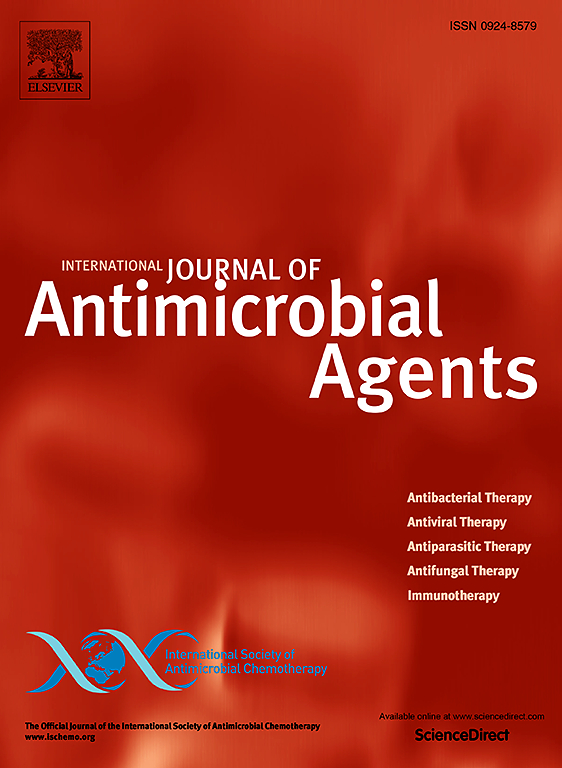有组织的奶牛生产系统中牛奶和粪便的微生物组和抗生素耐药性分析。
IF 4.6
2区 医学
Q1 INFECTIOUS DISEASES
International Journal of Antimicrobial Agents
Pub Date : 2025-08-13
DOI:10.1016/j.ijantimicag.2025.107590
引用次数: 0
摘要
抗微生物药物耐药性(AMR)是一项重大的公共卫生挑战,每年造成100多万人死亡。牲畜,特别是奶牛,由于在动物卫生部门广泛使用抗生素,在很大程度上加剧了抗生素耐药性危机。本研究旨在通过分析奶牛的粪便和牛奶宏基因组来表征其抗生素抗性组。我们从三个不同的有组织的奶牛场收集了36份牛奶和36份粪便样本,并提取了宏基因组DNA,分别获得了25.8和28.1亿个总读取量,分别贡献了200.4和206.5 GB的数据。这些读取的大部分都映射到细菌基因组,揭示了乳制品生产系统中的37个细菌门,与牛奶相比,在粪便中观察到更大的门水平多样性。鉴定出的优势门为杆状菌门(53.3%)、假单胞菌门(24.7%)、拟杆菌门(11.0%)和放线菌门(8.4%)。牛奶中的梭状芽孢杆菌和粪便中的双歧杆菌数量最多。总共鉴定出290种不同的耐药基因,涵盖27种不同的药物类别和12种耐药机制。粪便中抗生素抗性基因的丰度高于牛奶,牛奶中发现了229种不同的抗生素抗性基因。总的来说,氨基糖苷抗性基因在有组织的乳制品生产系统的牛的粪便和牛奶宏基因组中最为普遍和丰富。本文章由计算机程序翻译,如有差异,请以英文原文为准。

Microbiome and antibiotic resistance profile of milk and faeces from cattle in an organized dairy production system
Antimicrobial resistance (AMR) represents a critical public health challenge, responsible for over one million fatalities each year. Livestock, particularly dairy cattle, significantly contribute to the AMR crisis due to the extensive use of antibiotics in the animal health sector. This study aimed to characterize the antibiotic resistome of dairy cattle by analyzing their fecal and milk metagenomes. We collected 36 milk and 36 fecal samples from three different organized dairy farms and extracted metagenomic DNA, yielding 2.58 and 2.81 billion total reads contributing 200.4 and 206.5 GB data, respectively. The majority of these reads mapped to bacterial genomes, revealing 37 bacterial phyla within the dairy production system, with greater phylum-level diversity observed in feces compared to milk. The predominant phyla identified were Bacillota (53.3%), Pseudomonadota (24.7%), Bacteroidota (11.0%), and Actinomycetota (8.4%). The most abundant genera found were Clostridium in milk and Bifidobacterium in feces. In total, we identified 290 distinct antibiotic-resistant genes spanning 27 diverse drug classes and 12 resistance mechanisms. The abundance of antibiotic-resistant genes was higher in feces than in milk, with 229 distinct antibiotic-resistant genes found in milk. Overall, aminoglycoside-resistant genes were the most prevalent and abundant in both fecal and milk metagenomes of cattle from organized dairy production systems.
求助全文
通过发布文献求助,成功后即可免费获取论文全文。
去求助
来源期刊
CiteScore
21.60
自引率
0.90%
发文量
176
审稿时长
36 days
期刊介绍:
The International Journal of Antimicrobial Agents is a peer-reviewed publication offering comprehensive and current reference information on the physical, pharmacological, in vitro, and clinical properties of individual antimicrobial agents, covering antiviral, antiparasitic, antibacterial, and antifungal agents. The journal not only communicates new trends and developments through authoritative review articles but also addresses the critical issue of antimicrobial resistance, both in hospital and community settings. Published content includes solicited reviews by leading experts and high-quality original research papers in the specified fields.

 求助内容:
求助内容: 应助结果提醒方式:
应助结果提醒方式:


